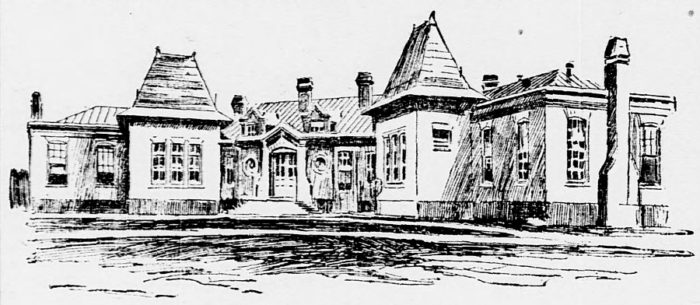 When we last looked at the smallpox hospital in Reservation 13, the job of designing it had been transferred from an accused felon to a local draftsman.
When we last looked at the smallpox hospital in Reservation 13, the job of designing it had been transferred from an accused felon to a local draftsman.
A few months later, the contract to build the hospital was given to Columbus Thomas of C. Thomas & Son. There were some delays in the project, partly because appropriations had only been made for the construction but not the furnishing thereof. However, on December 18, 1895, however, the Washington Morning Times reported that:
The Commissioners went at noon to inspect the new smallpox hospital at Reservation 13, which the contractor has completed and is now ready to turn over to the government.
It would be over two years until the hospital had its first patient, Robert S. Collins, a marine who had been in the Naval Hospital for some almost two weeks. It was a puzzling case, in that he had been admitted to the Naval Hospital for surgery, and everyone he had been in contact with had been vaccinated, but Dr. William C. Woodward [pictured], the District health officer, was sure that there was no need to worry about further cases. The question resolved itself when the patient received a letter from his mother stating that a local man had been infected, and Woodward surmised that the disease had been passed through a previous letter carrying the infection.
While this outbreak was extremely limited, the next one was not as benign. It began in Alexandria, Virginia, and spread all across the District starting on January 20, 1899. Over the course of the next six months, 96 patients were taken to the smallpox hospital. Only one died, owing to the “mild character” of the disease, as well as the quality of care given the patients at the new building.
This pattern would repeat over the next 25 years – an occasional single patient interspersed with more serious outbreaks of the disease. Patients exhibiting symptoms were taken to the hospital itself. Those only exposed would be taken to a quarantine hospital nearby until they either spent two weeks without showing symptoms or were transferred to the hospital if they came down with full-fledged smallpox.

A drawing of the hospital few years after it opened. (LOC)
In 1905, there was a bit of a crisis: Repairs had been made to the plumbing, but the Inspector of Plumbing refused to send one of his men out to check on the work. In the end, the decision was that the “vouchers will be passed upon favorably without the work being inspected, it being held that the contractors are known as responsible parties.”
A 1915 article gives a sense of how the hospital was being used: “During the fiscal year 1915 the hospital was open 156 days, 35 patients were treated, and the total number of patient days was 685.”
Thereafter, the use seems to have declined rapidly. In 1917, it was reported that some seven months had passed without a single patient.
It was therefore hardly surprising that a dozen years later, the hospital was closed and its functions were folded into the nearby Gallinger hospital. Gallinger would later be renamed D.C. General before being closed in 2001.
In 1939, in a brief aside in an article about the new head of Gallinger, it was reported that the old smallpox hospital, “long since abandoned” had been turned into a “not bad ear, nose and throat department.” When, exactly, the building was torn down, I was unable to determine: an unsurprising state of affairs, given the general reticence people had to writing about the place.
